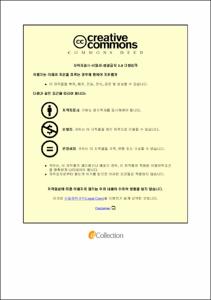Ulsan Univ. Repository
Thesis
General Graduate School
Mechanical & Automotive Engineering
1. Theses (Master)
SLM 방식의 3D 프린팅 및 무독성 후처리 공정으로 제작한 초소수성 금속 표면
- Abstract
- 초소수성 표면은 표면과 물방울의 접촉각(Contact Angle: CA)이 150 °이상인 상태로 일반적으로 표면의 자유에너지를 낮추고 거칠기를 부여하여 제작한다. 따라서 연구자들은 이를 위해 낮은 표면 에너지를 띄는 물질을 활용하며 표면에 나노/마이크로 크기의 요철구조를 제작해 초소수성 표면을 구현하는 연구를 활발히 진행하고 있다. 하지만 그러나 금속 초소수성 표면을 제작하기 위해서는 공정이 복잡하며 독성의 화학 물질을 사용하는 후처리 공정이 필요해 이를 단순화하고 친환경적인 제조 공정을 개발하는 데 많은 연구가 집중되고 있다.
따라서 본 논문에서는 선택적 용융방식(SLM)의 금속 3D프린팅과 무독성의 후처리 공정을 통한 금속 초소수성 제작 방법을 제안하였다. 티타늄과 마레이징강 분말을 활용해 제작하였으며 금속표면에 마이크로미터 크기의 요철 구조를 일정한 간격으로 배열시켰다. 요철구조의 직경은 200, 300, 400 μm 로 제작했고 요철구조 간 간격인 피치는 300 ~ 800 μm까지 제작했다. 이후 후처리 공정으로 인체에 무해한 무독성의 실리콘 오일을 활용한 열처리 과정을 더해 표면에너지를 낮추었다. 그 결과 제작된 표면은 150 °이상의 접촉각과 낮은 구름각(Sliding Anlge: SA)을 나타내는 초소수성 금속 표면을 제작할 수 있었다. 이를 통해 다양한 금속 소재를 활용할 수 있고 형상 자유도가 높은 금속 3D 프린팅의 장점을 살려 초소수성을 띄는 자유 곡면을 제작할 수 있었고 이를 활용해 초소수성 금속 3D 프린팅 부품 제작의 가능성을 확인할 수 있었다.
|Superhydrophobic surfaces are generally fabricated by lowering the free surface energy and imparting roughness in a state where the contact angle (CA) between the surface and the water droplet is 150° or more. Therefore, researchers are conducting research on fabricating a superhydrophobic surface by using materials with low surface energy and fabricating nano/micro-sized structures on the surface. However, in order to produce a metal superhydrophobic surface, the processes are complicated and a post-treatment process using toxic chemicals is required, so a lot of research is being focused on simplifying these processes and developing an eco-friendly manufacturing process.
Therefore, in this paper, a method for manufacturing superhydrophobic metal through selective melting method (SLM) metal 3D printing and non-toxic post-treatment process was proposed. It was manufactured using titanium and maraging steel powder, and micrometer-sized pillar structures were arranged at regular pitches on the metal surface. The diameter of the pillar structure was 200, 300, and 400 μm, and the pitch, which is the interval between the structures, was manufactured from 300 to 800 μm. Afterward, as a post-treatment process, a heat treatment process using non-toxic silicone oil that is harmless to the human body was added to lower the surface energy. As a result, the fabricated surface was able to produce a superhydrophobic metal surface exhibiting a contact angle of 150° or more and a low sliding angle (SA). Through this, various metal materials can be used and the advantage of metal 3D printing with a high degree of freedom of shape can be used to create a free-form surface with superhydrophobicity, and using this, the possibility of manufacturing superhydrophobic metal 3D printing parts was confirmed.
- Issued Date
- 2022
- Awarded Date
- 2022-02
- Type
- dissertation
- Affiliation
- 울산대학교
- Department
- 일반대학원 기계자동차공학과
- Advisor
- 천두만
- Degree
- Master
- Publisher
- 울산대학교 일반대학원 기계자동차공학과
- Language
- kor
- Rights
- 울산대학교 논문은 저작권에 의해 보호 받습니다.
- Appears in Collections:
- Mechanical & Automotive Engineering > 1. Theses (Master)
- 파일 목록
-
-
Download
 200000605321.pdf
기타 데이터 / 10.39 MB / Adobe PDF
200000605321.pdf
기타 데이터 / 10.39 MB / Adobe PDF
-
Items in Repository are protected by copyright, with all rights reserved, unless otherwise indicated.